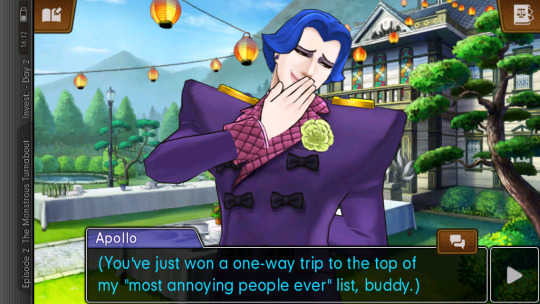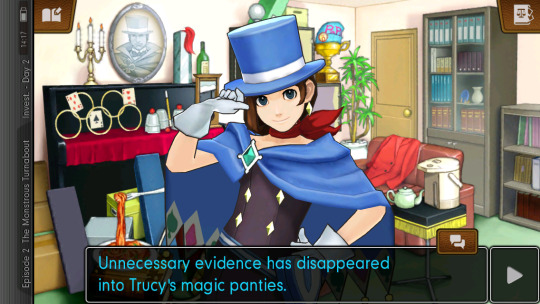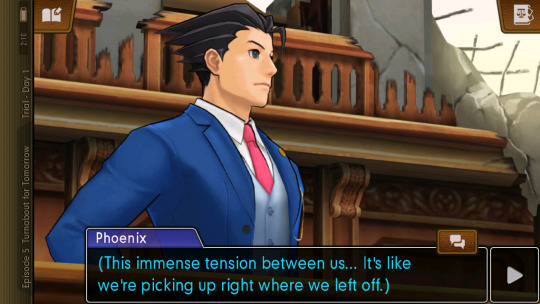#there are so many layers to this whole scene! it's so important for edgeworth's character development!
Text

why do people get so mad & act like you must just have shipping brainrot if you interpret this line as gay....... "you're ignoring the context!!!!!!" actually i'm not, i just have the ability to recognize that a vague line like this can have multiple interpretations & just because some interpret it as romantic, doesn't necessarily make it wrong.
#“but he even explained what he meant with 'unease and uncertainty'” that could still include (repressed) romantic feelings?????#idk man yall r so weird lmfao#there are so many layers to this whole scene! it's so important for edgeworth's character development!#it doesn't detract from any of that to think one of those layers could be that he's maybe on some deeper level talking about#repressed gay feelings. like........el oh el.#miles edgeworth#ace attorney#🎮 tag#send tweet
13 notes
·
View notes
Text
Some Thoughts on Ace Attorney: Dual Destinies
I recently finished reading the fifth Ace Attorney game, and really enjoyed it overall. However, while I’d definitely call myself a fan of the series, it’s always had its flaws alongside its strengths, and Dual Destinies especially requires wading through some irritating mechanics to get to its great finale. The following post highlights the pros and cons of Phoenix Wright’s fifth adventure in my opinion, with minimal spoilers until after the second screenshot.
One consistent issue I have with the series is its increasingly annoying witnesses. For every witness who’s actually an interesting and developed character—or who’s just a weirdo but at least a funny one—there seem to be five who drive me absolutely insane. One thing that really bothers me personally is when the witnesses’ quirks involve long animations that play in between their lines, like Vera and her sketchbook in the last one, or Aura and her repeated assault of her robot companion. I’d rather cross-examine Oldbag again than watch a character I’m already annoyed with impede my ability to find out what happens next by repeating an action I’ve already seen before getting on with their dialogue. And I could just be noticing it more the more I play, but I feel like that’s become more frequent as the series goes on. Maybe increasing budgets and/or technological advancements have been making more sprite movement possible, but just because you can do it doesn’t mean you should.

This line made me laugh because I actually do have a “most annoying witnesses ever” list, which I’ve been meaning to update to include several Dual Destinies characters.
I also have mixed feelings about how Dual Destinies seems to be easier and more linear than some of its predecessors. I sometimes felt like it was underestimating the intelligence of its audience when it would show a flashback to something that had just happened as if it thought I had forgot, or when the characters monologued internally about their ideas rather than letting me solve the mysteries myself. But some of its changes may have been for the better, such as the removal of superfluous evidence in between courtroom days, and the way investigation scenes now highlight objects you can interact with more clearly. While most Ace Attorney cases aren’t too hard to solve, I always had at least one moment in the older games when I got stuck, and ended up wandering between rooms aimlessly or futilely trying to present every piece of evidence I had. The streamlining of Dual Destinies prevents those moments of frustration, although it may also come at the cost of removing some of the challenge.

Thanks for making it easier to try to advance the plot through process of elimination when all else fails, Trucy.
That being said, while I’m not sure any case can beat the third game’s “Bridge to the Turnabout” in terms of tying everything together into a fun and surprising finale, “Turnabout for Tomorrow” comes pretty close.
When I first started Dual Destinies, I was pretty skeptical about the new characters and mechanics that were introduced. Why did they have to bring in Athena and her widget thing when there was already a ton going on both narrative- and game-mechanic-wise with Phoenix and Apollo? Why did they also introduce a new detective instead of sticking with the adorable Ema Skye, and what was up with the ridiculous notion of a convicted murderer working as a prosecutor? Of course, all of these questions were answered in “Turnabout for Tomorrow”, with the important roles Athena, Blackquill, and Fulbright had to play, and with the connection between Athena’s psychological cross-examination methods and an overall theme of the importance of expressing and understanding emotions. And the twist that the seemingly jovial and enthusiastic Fulbright was really the sociopathic phantom was quite a shocking one for me—I suspected Yuri Cosmos and even Candice Arme before gasping at the real revelation. Even after all of that, I initially thought the phantom’s layers of masks were just silly, but they set up that wonderfully disturbing sequence in which he switches between multiple masks while breaking down over his lack of a real identity just before his death. I should have learned by that point to trust that just like in the original trilogy, the Apollo Justice games are always headed somewhere interesting, even in their sillier moments.
It was also fantastic to see a reunion between Wright and Edgeworth, with the latter possibly acting more like a realistic prosecutor than any character in the series has before. I’ve talked a bit in the past about how it bothers me that so many prosecutors in these games seem to be motivated to do the job by either cartoonish villainy or their own personal vendettas, rather than a desire to work in tandem with the defense to ensure fair trials and uncover the real truth. Edgeworth did exactly what I wanted him to in this case, by being as objective as possible rather than trying extra hard to either help Phoenix or convict Athena. And the cutscene in which they began the trial in the ruins of the bombed courtroom has to have been one of my favourite moments out of the whole series. The defense was born ready!

This case did a lot to help fuel my Wright/Edgeworth shipping too.
All in all, while I found some aspects of Dual Destinies frustrating, I’m glad I kept playing through them in order to experience its great story. I’m really looking forward to starting Spirit of Justice soon.
#visual novel#visualnovel#ace attorney#dual destinies#phoenix wright#visual novel review#Visual Novel Reviews
4 notes
·
View notes